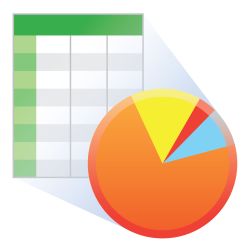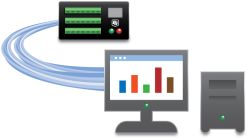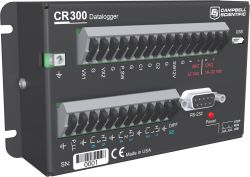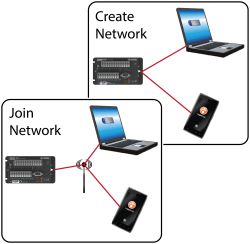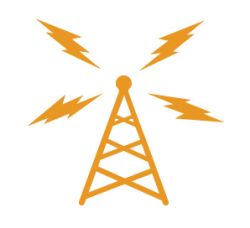This product is not available for new orders. We recommend ordering: CR350.
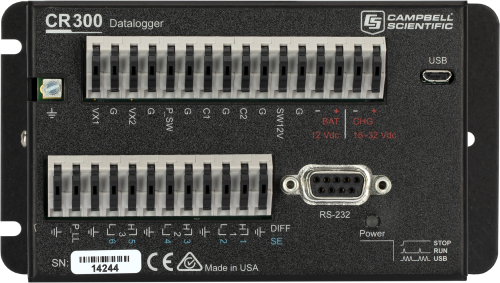
| Services Available |
|---|
Resumen
El CR300 es un datalogger multipropósito, compacto y de bajo costo. Este datalogger de nivel básico, pero potente en su conjunto de instrucciones, puede medir la mayoría de sensores utilizados en hidrología, meteorología, medio ambiente e industria. Concentra los datos, y los pone a disposición a través de variedad de redes y protocolos. El CR300 también realiza la toma de decisiones automática en el lugar o remotamente para control y comunicaciones M2M. El CR300 es ideal para pequeñas aplicaciones que requieran monitorización y control a largo plazo.
El CR300 dispone opcionalmente de comunicaciones WiFi, telefonía móvil, o radio para las siguientes áreas geográficas:
- CR300-RF407: US y Canada
- CR300-RF412: Australia y New Zealand
- CR300-RF422: Europa
- CR300-RF427: Brazil
Nota: Campbell Scientific no recomienda utilizar el CR300 como un PakBus router en redes con más de 50 dispositivos. Arrays muy grandes o variables tipo string pueden alcanzar los límites de memoria. Para estas aplicaciones recomendamos el CR1000X Measurement and Control Datalogger
Leer másVentajas y características
- Incluye puerto USB
- Medidas analógicas de alta resolución (conversor analógico digital de 24 bits)
- Medida de sensores serie por SDI-12 y/o RS-232
- Compatibilidad total con redes PakBus
- Página web embedida para consultas mediante navegador web
Imágenes













Ficheros CAD:
Descripción detallada
El CR300 es un datalogger de bajo consumo diseñado para la medida de sensores, analizar datos, y almacenar datos y programas. Incluye una pila interna para salvaguarda del reloj. El lenguaje de programación CRBasic, común a todos nuestros dataloggers Campbell Scientific, permite el procesado de datos y programar rutinas de análisis.
El panel de conexiones del CR300 incluye un terminal de 12V controlable por software, terminales de tierra repartidos entre los 6 terminales para medidas analógicas.
Preguntas frecuentes
Número de FAQs relacionadas con CR300: 4
Expandir todoDesplegar todo
-
The connector is designed to accept wire sizes from 14 to 28 AWG. Note: If you are using ferruled wire ends, reduce the maximum size to 18 AWG.
-
Verizon recommends using MIMO antennas because their 4G towers have at least two MIMO antennas. If your modem has two MIMO antennas as well, you may benefit from reduced signal reflections, more reliable data reception, and an increase in bandwidth.
While Verizon’s language indicates that MIMO antennas are required because they want to offer the best service possible to their users, technically, a MIMO antenna is not required for any of our products, including the CR300-CELL210 (which does not have a diversity port) and the RV50X and CELL210 (which do have a diversity port to accommodate MIMO antennas). Our users have found that a single antenna works well without noticeable issues.
Compatibilidad
Nota: lo siguiente muestra información de compatibilidad notable. No es una lista de todos los productos compatibles.
Software
| Producto | Compatible | Nota |
|---|---|---|
| DevConfig | Version 2.12 or higher | |
| LNDB | Version 1.3 or higher | |
| LoggerLink | Version 1.5 or higher | |
| LoggerNet | Version 4.4 or higher | |
| LoggerNet Mobile Connect | Version 1.1 or higher | |
| PC200 (retired) | Version 4.4 or higher | |
| PC400 | Version 4.4 or higher | |
| RTDAQ | ||
| Short Cut | Version 3.2 or higher |
Información de compatibilidad adicional
Sensores
El CR300 es compatible con casi todos los tipos de sensores, incluyendo sensores con salida en voltaje (de 0 a 2.5 V), corriente (0 a 20 mA o 4 a 20 mA), termistores, pt100, etc. También mide sensores con señales de salida de pulsos o frecuencia como anemómetros, pluviómetros, y medidores de flujo. También es compatible con sensores que se interroguen por SDI-12, Modbus, y otros sensores serie RS232 (mediante puertos C1 y C2 como par Tx/Rx). El CR300 no es compatible de forma directa con sensores RS485.
Periféricos de medida y control
El CR300 es compatible con relés de estado sólido de bajo nivel de amperaje de activación, pero no es compatible con dispositivos SDM o CDM.
Comunicaciones
El CR300 puede comunicar con un PC por USB. Dispositivos compatibles son el MD485 (RS485), modems telefonía móvil, radiomodems y transmisores satélite. Los datos pueden visualizarse en un móvil/tableta con iOS o Android (mediante software LoggerLink), con el display CD295 DataView II y con dispositivos de terceros.
| Opción Datalogger | Tipo comunicaciones | Las comunicaciones integradas son compatibles con |
|
CR300-WIFI |
2.4 GHz, 20 MHz bandwidth |
Most other Wi-Fi devices, such as the CR310-WIFI, CR6-WIFI, NL240 |
|
CR300-RF407 |
902 to 928 MHz Frequency Hopping Spread Spectrum |
|
|
CR300-RF412 |
915 to 928 MHz Frequency Hopping Spread Spectrum |
|
|
CR300-RF422 |
868 MHz SRD860 LBT+AFA |
|
|
CR300-CELL |
2G Frequency Bands 850, 900, 1800, 1900 |
GSM/GPRS/EDGE (2G) |
Alimentación
El CR300 se alimenta externamente y incluye cargador/regulador. De forma inteligente autoselecciona el mayor voltaje de las tres fuentes de voltaje de entrada (CHG, Bat, o USB) para funcionar en uno de los cuatro modos siguientes:
- UPS (recomendado) - fuente de entrada de 16 a 32Vdc, panel solar (SP5, SP10, SP20), o adaptador de corriente (29796) para cargar batería de 12Vdc, como nuestras BP7 o BP12.
- Batería de 12Vdc o adaptador de corriente de 12Vdc
- CHG - fuente alimentación DC de 16 a 32Vdc
- USB - alimentación de 5Vdc por USB para configurar, programar y testear el datalogger (no recarga batería ni proporciona 12Vdc en el terminal SW12)
Software
El CR300 es compatible con CRBasic (version 3.6 o superior).
Armarios
Para la mayoría de aplicaciones con el CR300, serán suficientes los armarios ENC10/12 o ENC12/14. Incluso en algunos casos, si el consumo del sistema es muy bajo, se podrá utilizar el ENC200 con una pequeña batería.
Especificaciones
| -NOTE- | Additional specifications are listed in the CR300-Series Specifications Sheet. |
| Operating Temperature Range |
|
| Maximum Scan Rate | 10 Hz |
| Case Material | Powder-coated aluminum |
| Analog Inputs | 6 single-ended or 3 differential (individually configured) |
| Pulse Counters | 8 (P_SW, P_LL, C1, C2, and SE1 to SE4) |
| Voltage Excitation Terminals | 2 (VX1, VX2) |
| Communications Ports |
|
| Switched 12 Volt | 1 terminal |
| Digital I/O | 7 terminals (C1, C2, P_SW, and SE1 to SE4) configurable for digital input and output. Includes status high/low, pulse width modulation, external interrupt, and communication functions. Exception: The SE4 terminal doesn't do external interrupt. |
| Input Limits | -100 to +2500 mV |
| Analog Voltage Accuracy |
|
| ADC | 24-bit |
| Power Requirements | 16 to 32 Vdc for charger input (CHG) (Current limited to 0.9 A maximum for power converter or solar panel input.) |
| Power Requirements | 10 to 18 Vdc for external batteries (BAT) |
| Real-Time Clock Accuracy | ±1 min. per month |
| Internet Protocols | Ethernet, PPP, RNDIS, ICMP/Ping, Auto-IP(APIPA), IPv4, IPv6, UDP, TCP, TLS (v1.2), DNS, DHCP, SLAAC, NTP, Telnet, HTTP(S), FTP(S), SMTP/TLS, POP3/TLS |
| Communications Protocols | PakBus, Modbus, DNP3, SDI-12, TCP, UDP, and others |
| CPU Drive/Programs | 80 MB serial flash |
| Data Storage | 30 MB serial flash |
| Idle Current Drain, Average | 1.5 mA (@ 12 Vdc) |
| Active Current Drain, Average |
|
| Dimensions |
13.97 x 7.62 x 4.56 cm (5.5 x 3.0 x 1.8 in.) Additional clearance required for cables and leads. |
| Weight | 242 to 250 g (0.53 to 0.55 lb) depending on communication option selected |
CR300-RF407 Option |
|
| Radio Type | Frequency Hopping Spread Spectrum (FHSS) |
| Output Power | 5 to 250 mW (user-selectable) |
| Frequency | 902 to 928 MHz (US, Canada) |
| RF Data Rate | 200 kbps |
| Receive Sensitivity | -101 dBm |
| Antenna Connector | RPSMA (External antenna required; see www.campbellsci.com/order/rf407 for Campbell Scientific antennas.) |
| Idle Current Drain, Average | 12 mA (@ 12 Vdc) |
| Active Current Drain, Average | < 80 mA (@ 12 Vdc) |
CR300-RF412 Option |
|
| Radio Type | Frequency Hopping Spread Spectrum (FHSS) |
| Output Power | 5 to 250 mW (user-selectable) |
| Frequency | 915 to 928 MHz (Australia, New Zealand) |
| RF Data Rate | 200 kbps |
| Receive Sensitivity | -101 dBm |
| Antenna Connector | RPSMA (External antenna required; see www.campbellsci.com/order/rf412 for Campbell Scientific antennas.) |
| Idle Current Drain, Average | 12 mA (@ 12 Vdc) |
| Active Current Drain, Average | < 80 mA (@ 12 Vdc) |
CR300-RF422 Option |
|
| Radio Type | 868 MHz SRD 860 with Listen Before Talk (LBT) and Automatic Frequency Agility (AFA) |
| Output Power | 2 to 25 mW (user-selectable) |
| Frequency | 863 to 870 MHz (European Union) |
| RF Data Rate | 10 kbps |
| Receive Sensitivity | -106 dBm |
| Antenna Connector | RPSMA (External antenna required; see www.campbellsci.com/order/rf422 for Campbell Scientific antennas.) |
| Idle Current Drain, Average | 9.5 mA |
| Active Current Drain, Average | 20 mA |
CR300-RF427 Option |
|
| Radio Type | Frequency Hopping Spread Spectrum (FHSS) |
| Output Power | 5 to 250 mW (user-selectable) |
| Frequency | 902 to 907.5 MHz/915 to 928 MHz (Brazil) |
| RF Data Rate | 200 kbps |
| Receive Sensitivity | –101 dBm |
| Antenna Connector | RPSMA (External antenna required.) |
| Idle Current Drain, Average | 12 mA (@ 12 Vdc) |
| Active Current Drain, Average | < 80 mA (@ 12 Vdc) |
CR300-WIFI Option |
|
| Operational Modes | Client or Access Point |
| Operating Frequency | 2.4 GHz, 20 MHz bandwidth |
| Antenna Connector | Reverse Polarity SMA (RPSMA) |
| Antenna | pn 16005 unity gain (0 dBd), 1/2 wave whip, omnidirectional with articulating knuckle joint for vertical or horizontal orientation |
| Transmit Power | 7 to 18 dBm (5 to 63 mW) |
CR300-CELL205 Option |
|
| -NOTE- | The CR300-CELL205 option is not compatible with a Verizon cellular network. |
| Certifications | IC (Industry Canada) 10224A-201611EC21A |
| Cell Technologies |
|
| 3G Frequency Bands | 850, 1700/2100 (AWS), and 1900 |
| 4G Frequency Bands | 700, 850, 1700/2100 (AWS-1), 1900 |
| Antenna Connector | SMA (External antenna required; see www.campbellsci.com/order/cr300 for Campbell Scientific antennas.) |
| SIM Interface |
3FF (6 position/contacts) Supports SIMs that require 1.8 or 3 V. |
| Radio Output Power |
|
| Radio Sensitivity Range | -99.5 to 110.5 dBm (10 M) |
CR300-CELL210 Option |
|
| -NOTE- | The CR300-CELL210 option is only compatible with a Verizon cellular network. |
| Cell Technologies | 4G (LTE CAT-1) |
| 4G Frequency Bands | 700, 850, 1700, 1900, 2100 |
| Antenna Connector | SMA (External antenna required; see www.campbellsci.com/order/cr300 for Campbell Scientific antennas.) |
| Power Consumption - Low Power Mode | 5 mA |
| Power Consumption - Idle | 35 mA |
| Power Consumption - Active | 70 mA |
| SIM Interface |
3FF (6 position/contacts) Supports SIMs that require 1.8 or 3 V. |
| Radio Output Power | 23 dBm on LTE |
| Radio Sensitivity Range | -99.5 to 110.5 dBm (10 M) |
CR300-CELL215 Option |
|
| -NOTE- | The CR300-CELL215 option is intended for use in EMEA countries. |
| Cell Technologies |
|
| 2G Frequency Bands | 900 and 1800 MHz |
| 3G Frequency Bands | 850, 900, and 2100 MHz |
| 4G Frequency Bands | 800, 850, 900, 1800, 2100, and 2600 MHz |
| Antenna Connector | SMA (External antenna required; see www.campbellsci.com/order/cr300 for Campbell Scientific antennas.) |
| SIM Interface |
3FF (6 position/contacts) Supports SIMs that require 1.8 or 3 V. |
| Radio Output Power |
|
| Radio Sensitivity Range | -99.5 to 110.5 dBm (10 M) |
CR300-CELL220 Option |
|
| -NOTE- | The CR300-CELL220 option is intended for use in Australia and New Zealand. |
| Cell Technologies |
|
| 3G Frequency Bands |
|
| 4G Frequency Bands |
|
| Antenna Connector | SMA (External antenna required; see www.campbellsci.com/order/cr300 for Campbell Scientific antennas.) |
| SIM Interface |
3FF (6 position/contacts) Supports SIMs that require 1.8 or 3 V. |
| Radio Output Power |
|
| Radio Sensitivity Range | -99.5 to 110.5 dBm (10 M) |
CR300-CELL225 Option |
|
| -NOTE- | The CR300-CELL225 option is intended for use in Japan. |
| Cell Technologies | 4G (LTE CAT-1) |
| 4G Frequency Bands | 800 (lower), 800 (upper), 850+, 900, 1800, and 2100 MHz |
| Antenna Connector | SMA (External antenna required; see www.campbellsci.com/order/cr300 for Campbell Scientific antennas.) |
| SIM Interface |
3FF (6 position/contacts) Supports SIMs that require 1.8 or 3 V. |
| Radio Output Power | 23 dBm on LTE |
| Radio Sensitivity Range | -99.5 to 110.5 dBm (10 M) |
Documentos
Folletos producto
Manuales
Documentos técnicos
- CR300 Series: CELL200-Series Cellular Module Firmware Update
- CR300-Series-WiFi Daughter Board OS Update Procedure
- Data Streaming
- The Link Budget and Fade Margin
- Line of Sight Obstruction
- Measuring a PRT or Thermistor without a Completion Resistor
- FTP Troubleshooting
- Modbus Troubleshooting Guide
- HTTP Troubleshooting
Misceláneo
Videos & Tutoriales
Descargas
CR300 Series OS v.11.02 (5.19 MB) 06-02-2025
This download is for the CR300 series of dataloggers including all CR300 and CR310 models. Execution of this download places the Operating System file(.obj) on your computer. It also updates the CRBasic Editor compiler and support files.
Why Update? This OS adds Campbell Cloud compatibility enhancements and resolves bugs found in the previous OS. See the revision history for a complete list. With this OS update, it is recommended that you also update the Device Configuration Utility to the most recent version so that new datalogger features are available in the utility.
Note/Warning: Campbell Scientific always recommends updating operating systems on site if possible. When remote updates are required, it is recommended that you implement the necessary precautions to handle unexpected OS upload complications. All datalogger settings should be retained when updated remotely. If you choose to roll back to a previous operating system, the datalogger settings will be reset to default.
Watch the Video Tutorial: Sending an OS to a Local Datalogger.
CR300 Series Wifi OS Update v.1.7.12 (1.97 MB) 13-05-2022
Manufacturer chipset maintenance update.
CR300 QuickStart Program (569 KB) 15-03-2016
The CRBasic program referenced in the CR300 QuickStart videos and manual.
Data Logger Wiring Excel Template (1 KB) 26-03-2024
This is a data logger wiring diagram spreadsheet template that accompanies the Wiring Diagram Video. The spreadsheet includes templates for CR6, CR1000X, CR300, CR310, and CR350 data loggers. The file is an Excel template and works best with Microsoft Excel.
Casos de aplicación
Overview In 2020, due to the COVID-19 pandemic, the Formula 1 World Championship calendar was subject......leer más
The Port of Townsville Limited (POTL) are undertaking the Channel Upgrade Project (CU Project). The......leer más
The Jukskei River is one of the largest rivers in Johannesburg, South Africa. The river......leer más
Located beneath a steep canyon near Douglas, Wyoming sits LaPrele Dam, privately owned by LaPrele......leer más
Introduction The Andes Mountains of Argentina are home to a rich and diverse group of organic......leer más
Everglades National Park is the largest tropical wilderness in the United States and was created......leer más
GKM Consultants was contracted by a nationally leading engineering firm to develop, commission, and install......leer más
The Ministry of Transportation Ontario (MTO) is responsible for monitoring and managing the province’s road......leer más







